Panayiotis Tetsis: Greece in Full Color
From bustling street markets to Hydra’s...
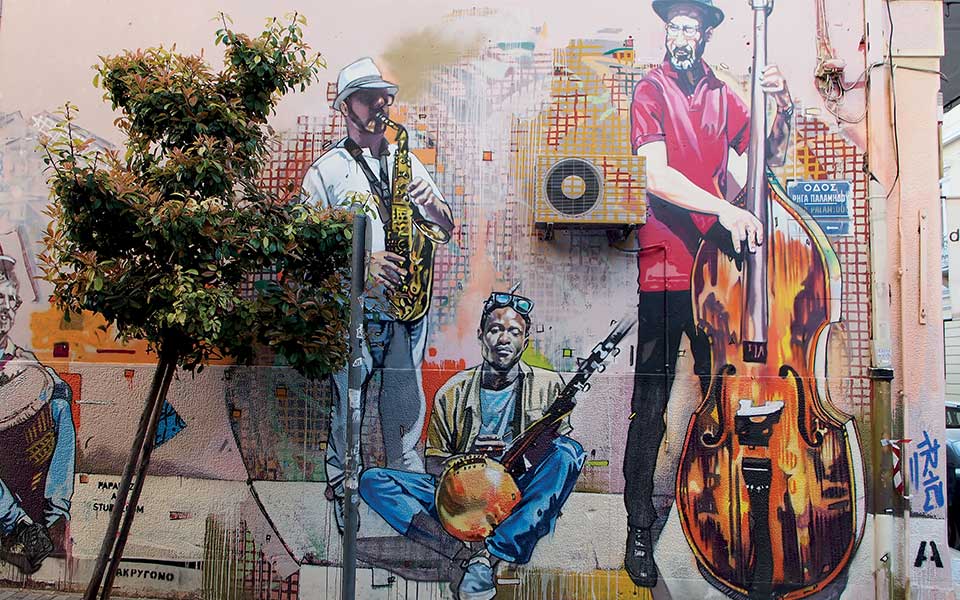
Paparazzi’s “Musicians,” one of the city’s most popular murals, on Riga Palamidou Street in Psyrri.
© Dimitris Tsoumplekas
The first time I spotted INO he was not so much dangling in mid-air as somewhat impossibly clinging to a tall wall in the Trouba district of Piraeus. His laser-beam focus on the hard surface to which he was furiously but meticulously applying brush strokes was nothing short of transfixing. He was finishing up; the wall had already been transformed into a towering piece of art, a whispery rendition of a mysterious lady in grayscale with deliberate daubs of blue.
Until then, I’d never realized just how much of an athletic feat this kind of aesthetic undertaking really is. Call it Spiderman-meets-Picasso, or something like that. Actually, call it what you will. When it comes to street art, looking for easy labels (is it conceptual? abstract? a manifesto?) may not be particularly helpful.
What is helpful is the abundance of art available to see; it’s wild out there. And it’s everywhere. Walk around Pangrati, in the thicket of streets that stretch out behind the Panathenaic Stadium, and you’ll come across the cheeky outlines of the Athenian Sailor, a rotund Popeye-style figure that’s the signature imprint of artist Dreyk the Pirate. Tiptoe behind the old OSY depot in Gazi, the building that recently housed an exhibition on Leonardo da Vinci, to find a monumental work by INO that will stop you in your tracks: a high-impact but playfully politicized repast called Last Supper in Athens.
Or venture into Psyrri, a hotbed of street art where riotous colors are seemingly plastered on every surface that isn’t a window. Over in Exarchia, which borders Kolonaki but is a million miles away from it temperamentally, Alex Martinez’s flamboyant depiction of a tropical jungle jazzes up the urban backdrop. It all adds up to a visual soundtrack for a city at once stuck like any other in its geo-coordinates yet in a constant swirl of motion; spend any length of time navigating the Athenian byways, and the effect is almost kaleidoscopic.
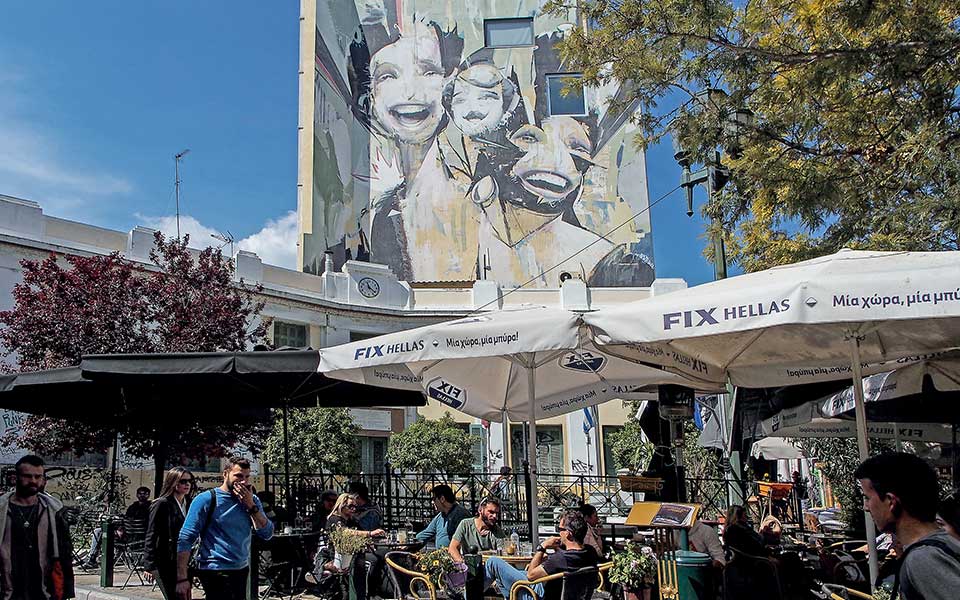
Alexandros Vasmoulakis’ suspiciously merry figures stand guard over bustling Iroon Square in Psyrri.
© Dimitris Tsoumplekas
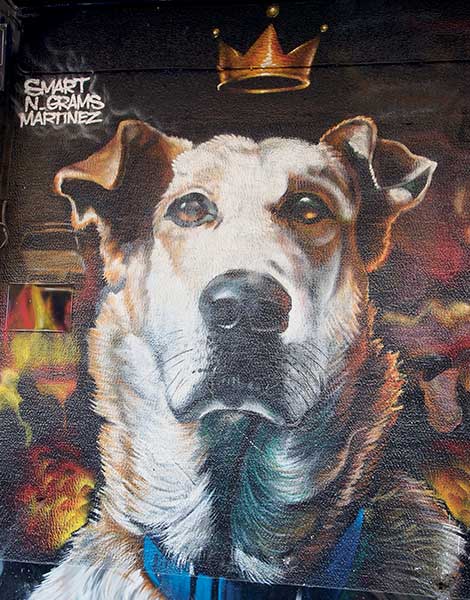
Smart, n_Grams, Alex Martinez and Billy G pay homage to Loukanikos, an Athens stray who rose to legendary status for being on the front line of every protest rally during the peak of the economic crisis.
© Dimirtis Tsoumplekas
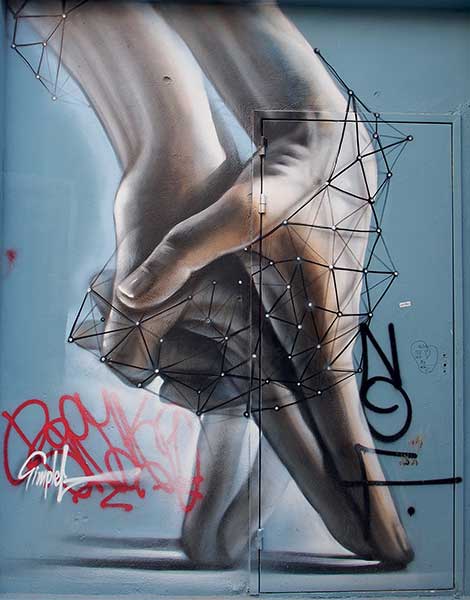
The pedestrian strip of Louka Nika is basically an open-air gallery.
© Dimirtis Tsoumplekas
From exuberant murals executed with astonishing levels of artistry to the most rudimentary graffiti “tags” and with lots in between, street art in Athens is now the contemporary counterpoint to the ancient ruins that have for centuries defined and dominated the city’s touristic iconography.
There was, indeed, a time when Athens wasn’t exactly the mecca of street art that it is today. Psyrri’s creative renaissance, for example, was galvanized by the 2004 Olympic Games; later, the economic crisis proved a further incentive for artists of varying degrees of rebelliousness to get out there and paint.
Nikos Tonga, whose street-art handle is “Rude” and who also happens to lead an excellent and insightful three-hour tour of street art for Alternative Athens, says “The crisis didn’t create street art, it just introduced a different inspiration for the artists plying their craft.”
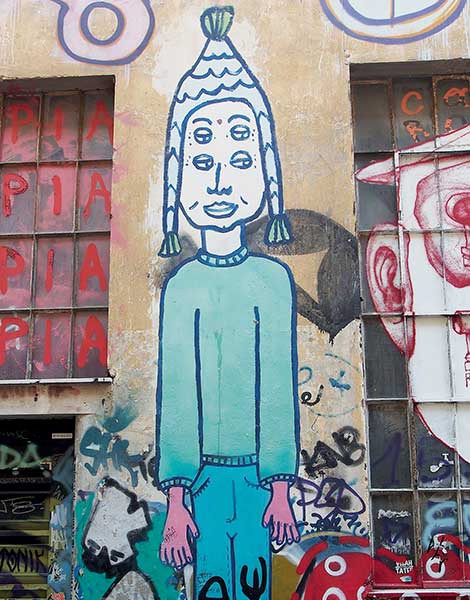
The walls of the Embros Theater have always lent themselves as a canvas to Athens’ street artists.
© Dimitris Tsoumplekas
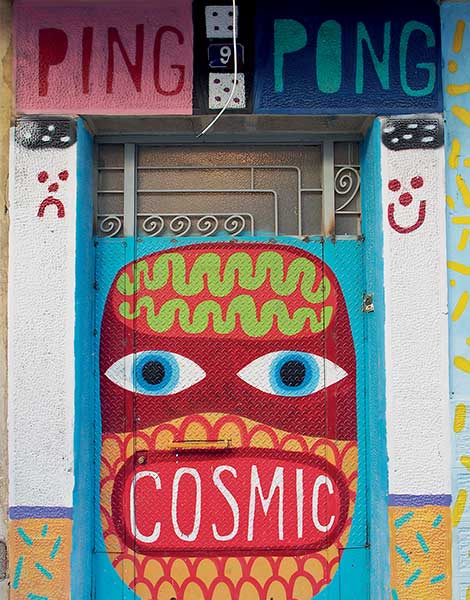
A detail from a piece by Malarko Hernandez and David Shillinglaw at 1 Evmorfopoulou.
© Dimitris Tsoumplekas
It’s not all spray paint. Some street artists prefer to use paint buckets instead because, as Dreyk the Pirate says: “The paintbrush sort of signals to the police, ‘Oh, let’s check out what he’s up to’ rather than ‘Let’s lock him up for it’.” But if you want to see a panoply of renegade art where the interpretation of what’s allowed and what’s not is very visibly elastic, try Metaxourgio, a scruffy neighborhood currently undergoing slow-motion gentrification, leaving behind its reputation as an outdoor shooting gallery for junkies framed by architectural disrepair.
Given its location between the already largely modernized Gazi and busy/buzzy Psyrri, this makes sense. The area doesn’t have the same reputation for anarchy as does Exarchia, the more rough-and-tumble repository of street art, but it’s still got a lot more grit than glamour. Things here are still resolutely defiant, sometimes raw. You’ll see things like a three-dimensional replica of an ancient Greek amphora doused in white paint and emblazoned with the stylized words “I feel so online,” and, less subtly, a primitive portrait of a well-known member of Golden Dawn, Greece’s far-right neo-Nazi party, with his head emerging from a toilet. Possibly derivative of Shepard Fairey’s now-iconic “Hope” image of Obama, this one carries a warning that is its political polar opposite.
These once-derelict and now newly resurgent districts have become the canvas for legions of graffiti artists, many of whom, like INO, studied at the Athens School of Fine Arts [see box]. And, as elsewhere, Athenian street art typically carries a message, which is sometimes clearly political but virtually always anti-commercial. “I want to feel the walls when I paint, to go to a place without any particular recipe,” INO declares. “And I want to spread art, not merchandise.”
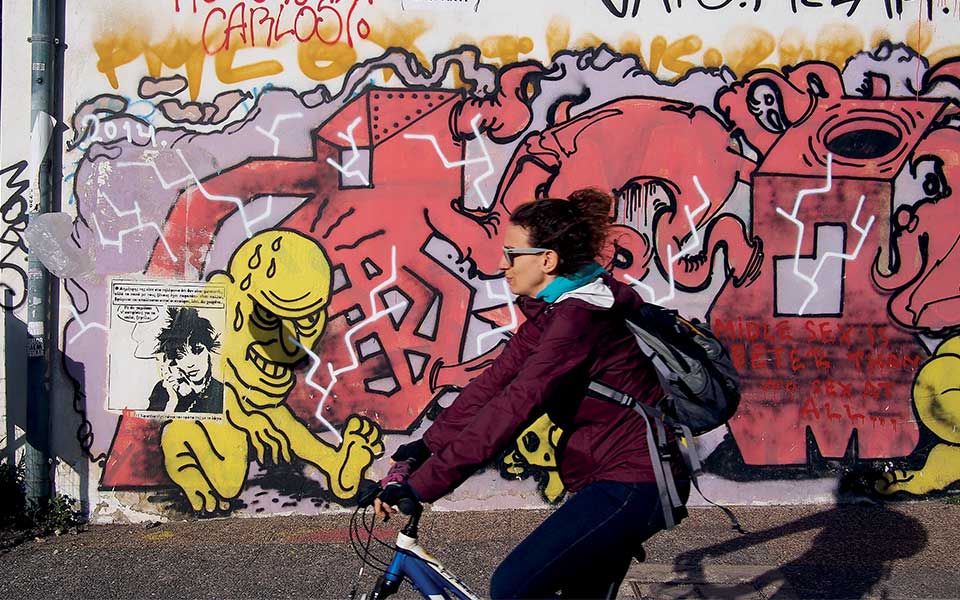
Walls all over Metaxourgeio, Psyrri and Exarchia are literally dripping with ink.
© Dimitris Tsoumplekas

“Believe in Dreams” is by the Balinese artist Wild Drawing, who has spent the past few years living and working in Athens.
© Dimitris Tsoumplekas
While that’s a sentiment likely to be echoed by the majority of street artists working in Athens today – creativity before commerce – it’s also true that we’re living in the era of Banksy and his many imitators, the age of “Instagrammability” and instant commodification of just about anything that sells. But it would be inaccurate to credit Banksy with the Athenian street art revolution. Because that compass points to New York, with a surprising Greek twist.
As Rude points out on his street tour, it was actually a Greek graffiti artist, TAKI 183, who started spray-painting his name around the streets of Manhattan in the early 1970s. Then along came Jean-Michel Basquiat, who tagged walls of the Lower East Side with the cryptic signature SAMO and whose work eventually caught the eye of Andy Warhol.
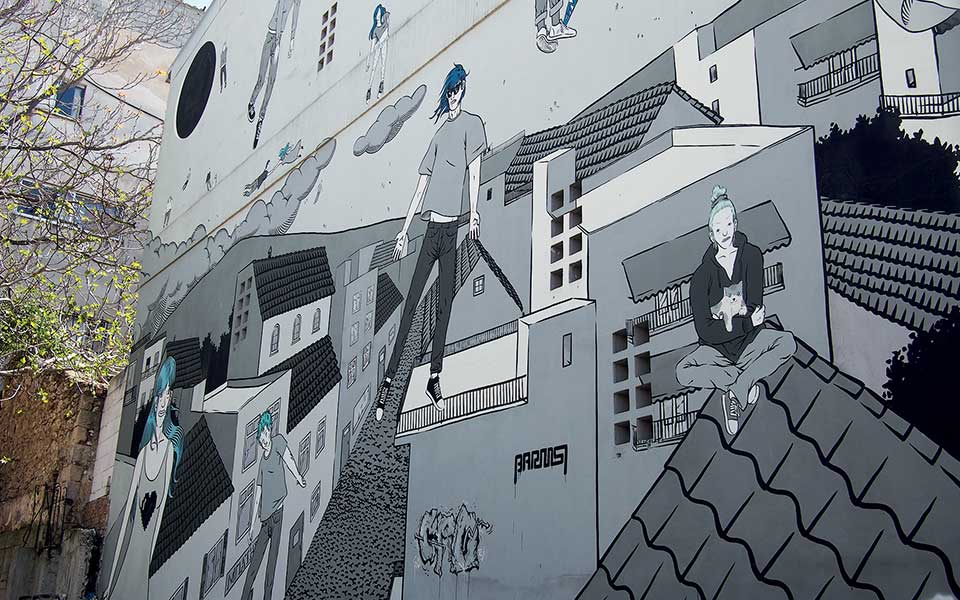
Tales of the city by Dimitris Taxis on an apartment block at 9 Agatharchou.
© Dimitris Tsoumplekas
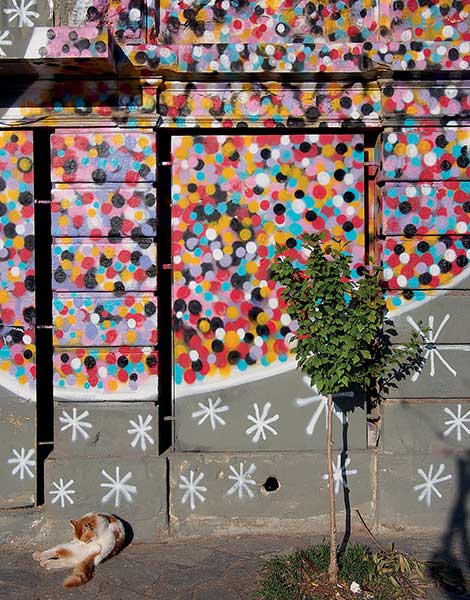
A cat suns itself beneath the colorful wings of “City Angels,” a piece by Cacao Rocks at Avdi Square in Metaxourgeio.
© Dimitris Tsoumplekas
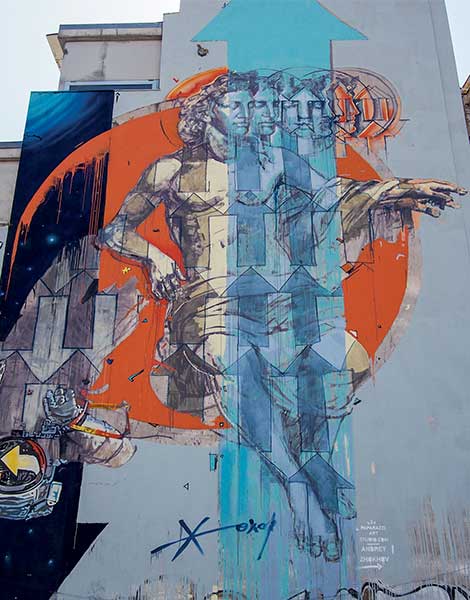
The ascension of Apollo and the fall of the astronaut in “Homo Deus,” a joint effort by Russia’s Andrey Zhokhov and local talent Paparazzi.
© Dimitris Tsoumplekas
It was, in fact, the gritty New York of that time and the synergy of artists like Basquiat and Haring with Warhol that first fired up the amorphous street art machine and, by doing so, paved the way for the legitimization of street art. And just as New York’s fiscal fragility may have led street artists to double down on their creative endeavors, so too did Greece’s dark days of austerity conspire to create other forms of illumination.
There’s something about Athens, however, that casts its street art in a different light than that of London or New York. It’s the inescapable presence of antiquity: only in Athens do you have the juxtaposition of a very ancient urban aesthetic – the Parthenon and Acropolis and the Panathenaic Stadium all loom large, not just in the physical space of the city but in the collective conception of what defines Athens as a great city – with outdoor artworks telegraphing messages and colors you’ll never find on a Doric column.
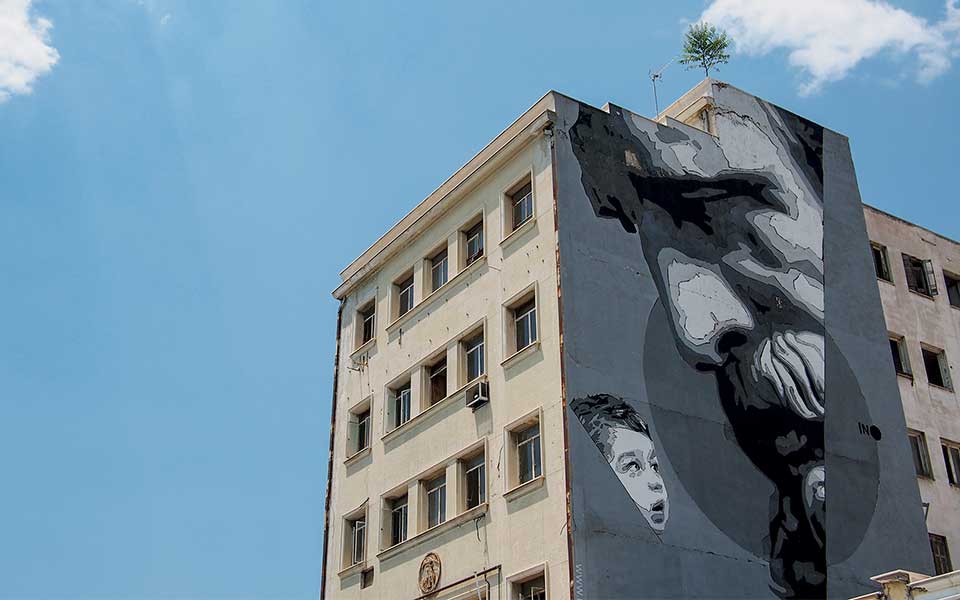
A young boy meets Democritus at the port of Piraeus in “We Have the Power” by INO.
© Dimitris Tsoumplekas
INO, a native of Piraeus, will not reveal his full name, age or astrological sign, but can confirm that, from 2000 to 2004, he was part of the young Athenian graffiti generation: he calls that period “a blast of vandalism, armed with spray paint.” He also states that he studied in the Athens School of Fine Arts for five years, ending his studies about ten years ago. His objective was never to find celebrity as a street artist, but he says: “The good thing about fame is that it gives you an opportunity to develop in more directions.”
What inspires you to paint?
When I paint I want to describe the facts of a situation. It’s a visual description.
Do you have a favorite color?
You might say light blue, but I like combinations and also monochromatic stuff. That’s why I use the grayscale with its inherent contradictions and after, some light blue to calm things a bit, give an extra tone. It’s the cherry on the pie.
How do you paint? Let’s talk technique…
When you paint on a surface like a wall, you usually have to make a composition, also taking into account what will be the spectator’s perspective. You have to consider all this and use your own inspirations of course; I paint what I like to see and start with a free sketch on paper.
On the street, I may have a tablet or a mobile for reference, but no projectors or anything like that. I’m more ‘artist’ when I visualize, but when I’m executing that vision on the street, I’m more ‘technician’. I want to have a balance between technique and inspiration, style and idea. At least, I’m looking for that balance now; it may change in the future.
What’s the craziest thing that’s ever happened to you while outside painting?
When I was painting the Da Vinci wall, some crazy guy came by and asked me to stop what I was doing and paint Stalin instead.
Is your version of Last Supper kind of a political statement?
I don’t want to have any political side or affiliation. As regards all that, I’d rather be more like a kid.
What might we expect to see with your signature on it in the next six to ten months?
Large-scale murals in downtown Athens. I’ve just finished some rope-training exercises. [The calluses on his hands bear this out]. I’m getting ready for some work that’s more personal.
From bustling street markets to Hydra’s...
At 1,160m, Metsovo blends preserved mountain...
Tourists share the highs and lows...
Beneath the busy streets of modern...